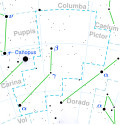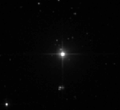A debris disk (American English), or debris disc (Commonwealth English), is a circumstellar disk of dust and debris in orbit around a star. Sometimes...
27 KB (2,357 words) - 19:16, 17 July 2024
Zeta Reticuli (section Alleged debris disk)
coming from a two-lobed structure that looked like a debris disk seen edge-on. This debris disk interpreted as an analogy to the Kuiper belt with a semi-major...
24 KB (2,130 words) - 13:42, 22 August 2024
the debris disks around these examples (e.g. Vega, Alphecca, Fomalhaut, etc.) are not truly "protoplanetary", but represent a later stage of disk evolution...
21 KB (2,139 words) - 00:18, 1 August 2024
Vega (category Circumstellar disks)
have a circumstellar disk of dust. This dust is likely to be the result of collisions between objects in an orbiting debris disk, which is analogous to...
91 KB (9,577 words) - 00:08, 23 July 2024
piece of space debris falling to Earth leaves a fiery trail, just like a meteor. A debris disk is a circumstellar disk of dust and debris in orbit around...
9 KB (1,138 words) - 19:50, 21 April 2024
White dwarf (section Debris disks and planets)
the white dwarf, until it will eventually sublimate and the disk will disappear. A debris disk will have a lifetime of around a few million years for white...
164 KB (18,719 words) - 11:36, 18 August 2024
Pulsar planet (section Debris disks and precursors)
interaction with a more massive one; the light white dwarf gives rise to a debris disk that generates a planet while the larger white dwarf becomes a pulsar...
46 KB (5,370 words) - 14:08, 29 July 2024
Fomalhaut (category Circumstellar disks)
by several debris disks. The inner disk is a high-carbon small-grain (10–300 nm) ash disk, clustering at 0.1 AU from the star. Next is a disk of larger...
50 KB (4,786 words) - 10:50, 20 August 2024
Beta Pictoris (category Circumstellar disks)
use of direct imagery. Both planets are orbiting in the plane of the debris disk surrounding the star. Beta Pictoris c is currently the closest extrasolar...
58 KB (6,140 words) - 15:57, 19 August 2024
AU Microscopii (category Circumstellar disks)
star. Like β Pictoris, AU Microscopii has a circumstellar disk of dust known as a debris disk and at least two exoplanets, with the presence of an additional...
40 KB (3,392 words) - 11:18, 19 July 2024
Tau Ceti (category Circumstellar disks)
be a Jovian planet between 3 and 20 AU from the star. Because of its debris disk, any planet orbiting Tau Ceti would face far more impact events than...
63 KB (6,863 words) - 02:30, 18 August 2024
excess and could be similar to Peter Pan disks. 2MASS 08093547-4913033, which is one of the M-dwarfs with a debris disk in NGC 2547 was observed with the Spitzer...
24 KB (2,557 words) - 23:26, 26 August 2024
HR 8799 (category Circumstellar disks)
9 times its luminosity. It is part of a system that also contains a debris disk and at least four massive planets. These planets were the first exoplanets...
43 KB (3,976 words) - 19:15, 25 August 2024
Gliese 581 (redirect from Gliese 581's debris disk)
three planets discovered using the radial velocity method, along with a debris disk. The system's notability is due primarily to early exoplanetology discoveries...
53 KB (5,373 words) - 21:49, 18 July 2024
Circumstellar disc (redirect from Circumstellar disk)
inner radius. Protoplanetary disks and debris disks can be imaged with different methods. If the disk is seen edge-on, the disk can sometimes block the light...
29 KB (3,603 words) - 05:21, 30 August 2024
circumstellar disks that have published resolved images. Many of them are protoplanetary disks or debris disks. Only some are transitional disks between protoplanetary...
84 KB (7,061 words) - 09:08, 18 July 2024
HD 69830 (section Debris disk)
were updated in 2023. In 2005, the Spitzer Space Telescope detected a debris disk in the HD 69830 system consistent with being produced by an asteroid...
16 KB (1,306 words) - 05:05, 21 August 2024
planet exists such that it has created those accumulations. Disks of space dust (debris disks) surround many stars. The dust can be detected because it...
134 KB (15,271 words) - 19:20, 30 August 2024
HD 98800 (category Circumstellar disks)
98800 A and HD 98800 B each of which contains two stars. In 2007, a debris disk was discovered orbiting HD 98800 B consisting of two rings which indicates...
19 KB (1,780 words) - 04:04, 23 August 2024
Fomalhaut C (category Circumstellar disks)
Solar System's age. In December 2013, a debris disk was discovered around this star. This is the second debris disk in the system, as a first one was discovered...
12 KB (1,201 words) - 00:43, 29 July 2024
Planetesimal (category Circumstellar disks)
(/ˌplænɪˈtɛsɪməlz/) are solid objects thought to exist in protoplanetary disks and debris disks. Believed to have formed in the Solar System about 4.6 billion years...
11 KB (1,163 words) - 15:20, 19 July 2024
LSPM J0207+3331 (category Circumstellar disks)
between 550–1400 K. It may be a debris disk created from asteroids broken apart by the star's gravity. The inner disk is optically thick with an inner...
7 KB (750 words) - 07:08, 25 July 2024
61 Virginis (category Circumstellar disks)
wavelength of 160 μm. This indicated the presence of a debris disk in orbit around the star. This disk was resolved at 70 μm. It was then thought to correspond...
21 KB (1,931 words) - 12:15, 17 July 2024
949 planetary systems, with 1007 systems having more than one planet. Debris disks are known to be common while other objects are more difficult to observe...
47 KB (5,460 words) - 14:19, 22 August 2024
out of a nebula to create a young protostar orbited by a protoplanetary disk. There are eight planets within the Solar System; planets outside of the...
9 KB (786 words) - 14:37, 23 August 2024
Glossary of astronomy (redirect from Tidal debris)
debris disk A ring-shaped circumstellar disc of dust and debris orbiting its host star. It is created by collisions between planetesimals. A debris disk...
161 KB (18,470 words) - 00:58, 21 August 2024
WISE J080822.18-644357.3 (category Circumstellar disks)
Myr old star system in the Carina constellation with a circumstellar debris disk orbiting an M-type red dwarf about 331 lightyears from Earth. On October...
10 KB (1,056 words) - 02:34, 19 July 2024
Scorpius–Centaurus association. The star is surrounded by a debris disk oriented 21 degrees away from HD 106906 b; this disk is about 65 AU (10 billion km; 6 billion mi)...
15 KB (1,617 words) - 08:07, 26 August 2024
Gamma Trianguli (section Debris disk)
Orbiting the star is a dusty debris disk with a combined mass of about 2.9 × 10−2 times the mass of the Earth. This disk can be detected because it is...
11 KB (830 words) - 07:20, 19 May 2024
the core behind. This crust and mantle material would then form the debris disk, which is now detected around the white dwarf. At first the size of the...
5 KB (510 words) - 14:37, 14 July 2024





















